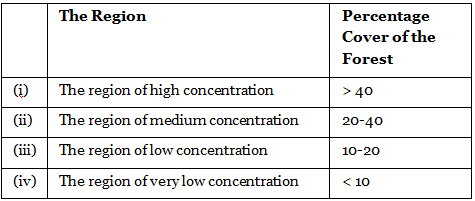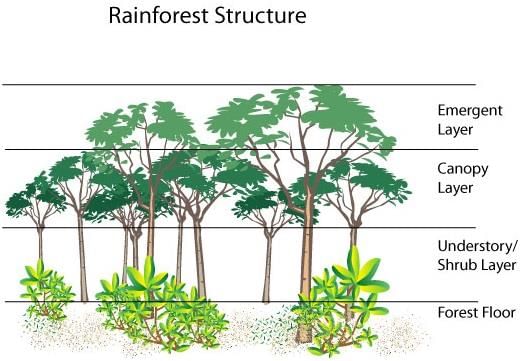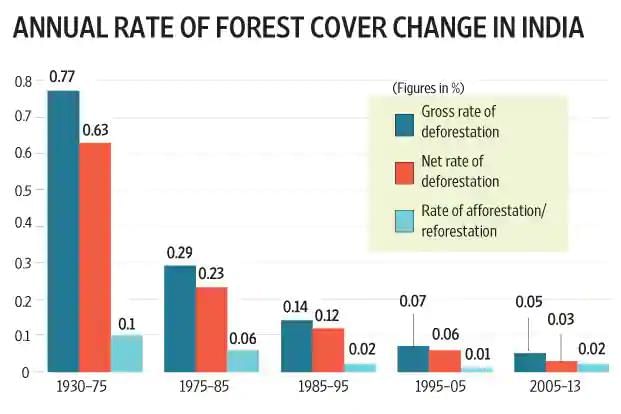NCERT Summary: Natural Vegetation - 1 | Geography for UPSC CSE PDF Download
| Table of contents |

|
| Introduction |

|
| Types of Forests |

|
| Forest Cover in India |

|
| Forest Conservation |

|
Introduction
Natural vegetation refers to a plant community that has been left undisturbed over a long time. So as to allow its individual species to adjust themselves to climate and soil conditions as fully as possible.
India is a land of great variety of natural vegetation. Himalayan heights are marked with temperate vegetation; the Western Ghats and the Andaman Nicobar Islands have tropical rain forests, the deltaic regions have tropical forests and mangroves; the desert and semi desert areas of Rajasthan are known for cacti, a wide variety of bushes and thorny vegetation. Depending upon the variations in the climate and the soil, the vegetation of India changes from one region to another.
Types of Forests
On the basis of certain common features such as predominant vegetation type and climatic regions, Indian forests can be divided into the following groups:
- Tropical Evergreen and Semi Evergreen forests
- Tropical Deciduous forests
- Tropical Thorn forests
- Montane forests
- Littoral and Swamp forests.

1. Tropical Evergreen and Semi Evergreen Forests
- These forests are found in the western slope of the Western Ghats, hills of the northeastern region and the Andaman and Nicobar Islands. They are found in warm and humid areas with an annual precipitation of over 200 cm and mean annual temperature above 220C.

- Tropical evergreen forests are well stratified, with layers closer to the ground and are covered with shrubs and creepers, with short structured trees followed by tall variety of trees. In these forests, trees reach great heights up to 60 m or above. There is no definite time for trees to shed their leaves, flowering and fruition. As such these forests appear green all the year round. Species found in these forests include rosewood, mahogany, aini, ebony, etc.
- The semi evergreen forests are found in the less rainy parts of these regions. Such forests have a mixture of evergreen and moist deciduous trees. The under growing climbers provide an evergreen character to these forests. Main species are white cedar, hillock and kail.
- The British were aware of the economic value of the forests in India, hence, large scale exploitation of these forests was started. The structure of forests was also changed. The oak forests in Garhwal and Kumaon were replaced by pine (chirs) which was needed to lay railway lines. Forests were also cleared for introducing plantations of tea, rubber and coffee. The British also used timber of construction activities as it acts as an insulator of heat. The protectional use of forests was, thus, replaced by commercial use.
2. Tropical Deciduous Forests
- These are the most widespread forests in India. They are also called the monsoon forests. They spread over regions which receive rainfall between 70-200 cm. On the basis of the availability of water, these forests are further divided into moist and dry deciduous.
- The Moist deciduous forests are more pronounced in the regions which record rainfall between 100-200 cm. These forests are found in the northeastern states along the foothills of Himalayas, eastern slopes of the Western Ghats and Odisha. Teak, sal, shisham, hurra, mahua, amla, semul, kusum and sandalwood etc. are the main species of these forests.
- Dry deciduous forest covers vast areas of the country, where rainfall ranges between 70-100 cm. On the wetter margins, it has a transition to the moist deciduous, while on the drier margins to thorn forests. These forests are found in rainier areas of the Peninsula and the plains of Uttar Pradesh and Bihar. In the higher rainfall regions of the Peninsular plateau and the northern Indian plain, these forests have a parkland landscape with open stretches in which teak and other trees interspersed with patches of grass are common.
- As the dry season begins, the trees shed their leaves completely and the forest appears like a vast grassland with naked trees all around Tendu, palas, amaltas, bel, khair, axlewood, etc. are the common trees of these forests. In the western and southern part of Rajasthan, vegetation cover is very scanty due to low rainfall and overgrazing.
3. Tropical Thorn Forests
- Tropical thorn forests occur in the areas which receive rainfall less than 50 cm. These consist of a variety of grasses and shrubs. It includes semi-arid areas of south west Punjab, Haryana, Rajasthan, Gujarat, Madhya Pradesh and Uttar Pradesh. In these forests, plants remain leafless for most part of the year and give an expression of scrub vegetation. Important species found are babool, ber, and wild date palm, khair, neem, khejri, palas, etc. Tussocky grass grows upto a height of 2 m as the under growth.
4. Montane Forests
- In mountainous areas, the decrease in temperature with increasing altitude leads to a corresponding change in natural vegetation. Mountain forests can be classified into two types, the northern mountain forests and the southern mountain forests.

- The Himalayan ranges show a succession of vegetation from the tropical to the tundra, which change in with the altitude. Deciduous forests are found in the foothills of the Himalayas. It is succeeded by the wet temperate type of forests between an altitudes of 1,000-2,000 m.
- In the higher hill ranges of northeastern India, hilly areas of West Bengal and Uttaranchal, evergreen broad leaf trees such as oak and chestnut are predominant. Between 1,500-1,750 m, pine forests are also well-developed in this zone, with Chir Pine as a very useful commercial tree. Deodar, a highly valued endemic species grows mainly in the western part of the Himalayan range. Deodar is a durable wood mainly used in construction activity. Similarly, the chinar and the walnut, which sustain the famous Kashmir handicrafts, belong to this zone. Blue pine and spruce appear at altitudes of 2,225-3,048 m. At many places in this zone, temperate grasslands are also found.
- But in the higher reaches there is a transition to Alpine forests and pastures. Silver firs, junipers, pines, birch and rhododendron, etc. occurs between 3,000- 4,000 m. However, these pastures are used extensively for transhumance by tribes like the Gujjars, the Bakarwals, the Bhotiyas and the Gaddis. The southern slopes of the Himalayas carry a thicker vegetation cover because of relatively higher precipitation than the drier north-facing slopes. At higher altitudes, mosses and lichens form part of the tundra vegetation.
- The southern mountain forests include the forests found in three distinct areas of Peninsular India viz; the Western Ghats, the Vindhyas and the Nilgiris. As they are closer to the tropics, and only 1,500 m above the sea level, vegetation is temperate in the higher regions, and subtropical on the lower regions of the Western Ghats, especially in Kerala, Tamil Nadu and Karnataka. The temperate forests are called Sholas in the Nilgiris, Anaimalai and Palani hills. Some of the other trees of this forest of economic significance include magnolia, laurel, cinchona and wattle. Such forests are also found in the Satpura and the Maikal ranges.

5. Littoral and Swamp Forests
India has a rich variety of wetland habitats. About 70 per cent of this comprises areas under paddy cultivation. The total area of wetland is 3.9 million hectares. Two sites-Chilika Lake (Odisha) and Keoladeo National Park (Bharatpur) are protected as water-fowl habitats under the Convention of Wetlands of International Importance (Ramsar Convention).
The country’s wetlands have been grouped into eight categories:
- The reservoirs of the Deccan Plateau in the south together with the lagoons and other wetlands of the southern west coast.
- The vast saline expanses of Rajasthan, Gujarat and the Gulf of Kachchh;
- Freshwater lakes and reservoirs from Gujarats through Rajasthan (Keoladeo National Park) and Madhya Pradesh.
- The delta wetlands and lagoons of India’s east coast (Chilika Lake);
- The freshwater marshes of the Gangetic Plain.
- The floodplains of the Brahmaputra; the marshes and swamps in the hills of northeast India and the Himalayan foothills.
- The lakes and rivers of the montane region of Kashmir and Ladakh; and
- The mangrove forest and other wetlands of the island arcs of the Andaman and Nicobar Islands Mangroves grow along the coasts in the salt marshes, tidal creeks, mud flats and estuaries.
They consist of a number of salt tolerant species of plants. Crisscrossed by creeks of stagnant water and tidal flows, these forests give shelter to a wide variety of birds.
In India, the mangrove forests spread over 6,740 sq. km which is 7 percent of the world’s mangrove forests. They are highly developed in the Andaman and Nicobar Islands and the Sundarbans of West Bengal. Other areas of significance are the Mahanadi, the Godavari and the Krishna deltas. These forests too, are being encroached upon, and hence, need conservation.
Forest Cover in India
- According to state records, the forest area covers 23.28 percent of the total land area of the country. The forest area is the area notified and recorded as the forest land irrespective of the existence of trees, while the actual forest cover is the area occupied by forests with canopy.

- The former is based on the records of the State Revenue Department, while the latter is based on aerial photographs and satellite imageries. In 2001, the actual forest cover was only 20.55 percent. Of the forest cover, the share of dense and open forests was 12.60 per cent and 7.87 percent respectively.
- Both forest area and forest covers vary from state to state. Lakshadweep has zero percent forest area; Andaman and Nicobar Islands have 86.93 percent. Most of the states with less than 10 percent of the forest area lie in the north and northwestern part of the country. These are Rajasthan, Gujarat, Punjab, Haryana and Delhi.
- Most of the forests in Punjab and Haryana have been cleared for cultivation. States with 10-20 percent forest area are Tamil Nadu and West Bengal. In Peninsular India, excluding Tamil Nadu, Dadra and Nagar Haveli and Goa, the area under forest cover is 20-30 percent. The northeastern states have more than 30 percent of the land under forest. Hilly topography and heavy rainfall are good for forest growth.
- There is a lot of variation in actual forest cover, which ranges from 9.56 per cent in Jammu and Kashmir to 84.01 per cent in Andaman and Nicobar Islands. From the table showing the distribution of forests in India, it is clear that there are 15 states where the forest cover is more than one-third of the total area, which is the basic requirement for maintaining the ecological balance.
On the basis of the percentage of the actual forest cover, the states have been grouped into four regions.
Forest Conservation
Forests have an intricate interrelationships with life and environment. These provide numerous direct and indirect advantages to our economy and society. Hence, conservation of forest is of vital importance to the survival and prosperity of mankind.
Accordingly, the Government of India proposed to have a nation-wide forest conservation policy, and adopted a forest policy in 1952, which was further modified in 1988. According to the new forest policy, the Government will emphasis sustainable forest management in order to conserve and expand forest reserve on the one hand, and to meet the needs of local people on the other.
The forest policy aimed at:
(i) Bringing 33 percent of the geographical area under forest cover;
(ii) Maintaining environmental stability and to restore forests where ecological balance was disturbed;
(iii) Conserving the natural heritage of the country, its biological diversity and genetic pool;
(iv) Checks soil erosion, extension of the desert lands and reduction of floods and droughts;
(v) Increasing the forest cover through social forestry and afforestation on degraded land;
(vi) Increasing the productivity of forests to make timber, fuel, fodder and food available to rural population dependence on forests, and encourage the substitution of wood;
(vii) Creating of a massive peoples movement involving women to encourage planting of trees, stop felling of trees, and thus, reduce pressure on the existing forest.
Based on the forest conservation policy the following steps were initiated:
➢ Social Forestry
Social forestry means the management and protection of forests and afforestation on barren lands with the purpose of helping in the environmental, social and rural development.
The National Commission on Agriculture (1976) has classified social forestry into three categories. These are Urban forestry, Rural forestry and Farm forestry.
- Urban forestry pertains to the raising and management of trees on public and privately owned lands in and around urban centres such as green belts, parks, roadside avenues, industrial and commercial green belts, parks, roadside avenues, industrial and commercial green belts, etc.
- Rural forestry lays emphasis on promotion of agro-forestry and community forestry. Agro-forestry is the raising of trees and agriculture crops on the same land inclusive of the waste patches. It combines forestry with agriculture, thus, altering the simultaneous production of food, fodder, fuel, timber and fruit.
- Community forestry involves the raising of trees on public or community land such as the village pasture and temple land, roadside, canal bank, strips along railway lines, and schools etc. Community forestry programme aims at providing benefits to the community as a whole. Community forestry provides a means under which the people of landless classes can associate themselves in tree raising and thus, get those benefits which otherwise are restricted for landowners.
|
175 videos|472 docs|197 tests
|
FAQs on NCERT Summary: Natural Vegetation - 1 - Geography for UPSC CSE
| 1. What are the different types of forests in India? |  |
| 2. How much forest cover does India have? |  |
| 3. What is the importance of forest conservation? |  |
| 4. How does the NCERT textbook define natural vegetation? |  |
| 5. Why are mangrove forests important? |  |

|
Explore Courses for UPSC exam
|

|






















